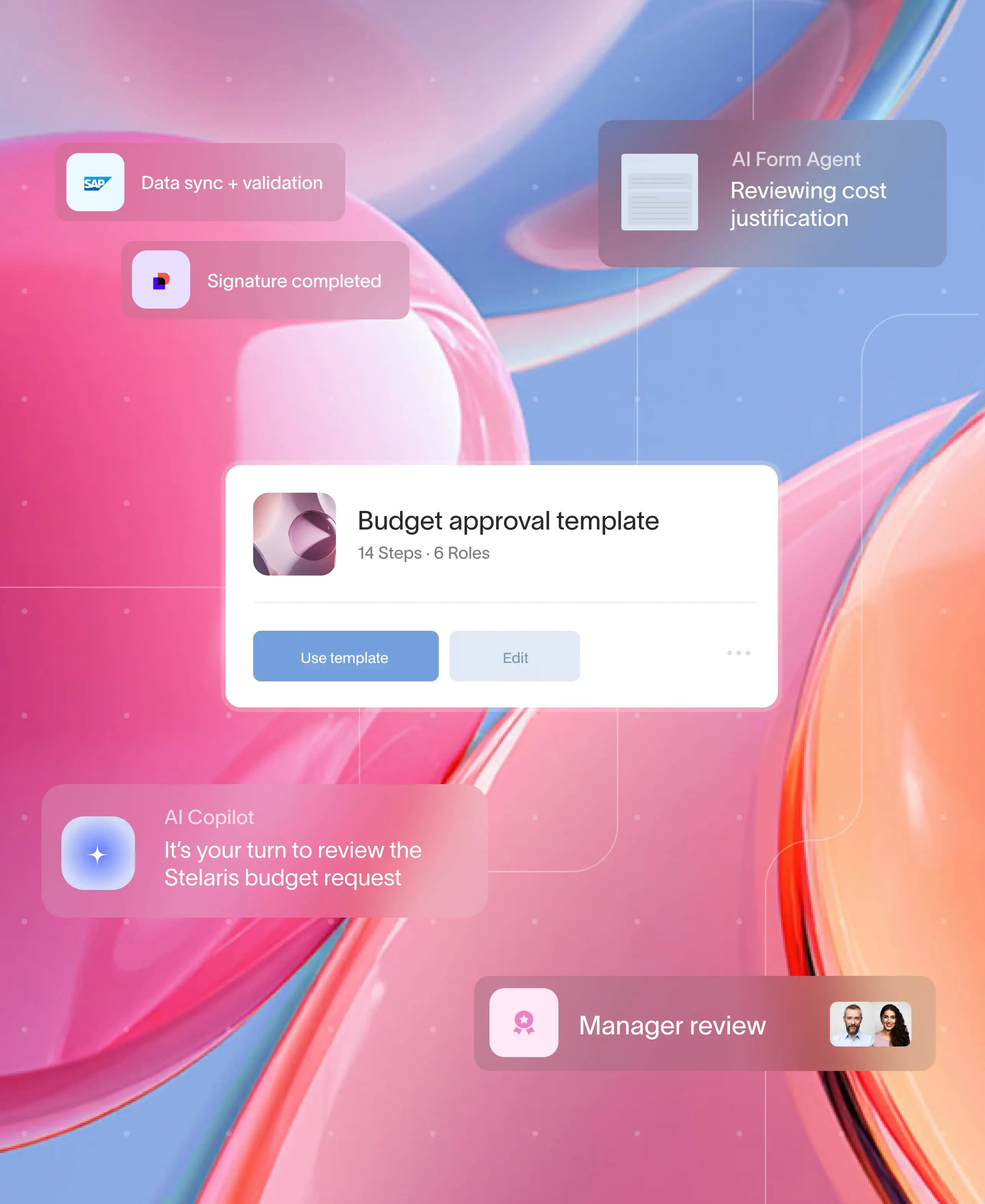.png)
Marketing today moves fast – too fast for teams not to rely on manual processes. Whether it’s coordinating cross-channel campaigns, sending nurture emails, or tracking lead activity, every delay adds friction. In client-centric workflows, every delay can impact satisfaction and results. That’s where marketing workflow automation makes a difference.
It is the process of using technology to streamline repetitive marketing tasks and trigger actions based on specific conditions or customer behavior. For client service teams, it ensures campaigns stay on track, approvals are captured, and interactions remain seamless.
From lead qualification to re-engagement campaigns, automated marketing workflows help teams do more with fewer resources while keeping customers engaged at every step. In this guide, we’ll explain how marketing automation workflows work, what you can automate, and how to build your flows–from planning to execution.
Understanding marketing workflows and the impact of automation
A marketing workflow is a sequence of tasks that guides how marketing campaigns are planned, executed with clients, and measured. These workflows can involve everything from client kickoff coordination to sending welcome emails to scheduling social posts or routing leads to sales teams. They define who does what, when, and how, ensuring campaigns run smoothly.
Marketing workflow automation powers these processes with technology. Instead of manually triggering actions or tracking campaign status across tools, automated workflows run based on rules and real-time behaviors.
Automated marketing workflows are used across every marketing campaign – email marketing, lead nurturing, event promotion, and post-sale engagement. In client-facing services, this means fewer back-and-forths, more transparency, and smoother execution across the client journey.
In short, automated marketing workflows transform marketing collaborations from reactive to proactive, enabling predictable, scalable engagement that aligns with business goals.
The impact of marketing workflow automation on team performance and the customer experience
Marketing workflow automation doesn’t just streamline operations – it enhances how businesses engage with clients and stakeholders. When workflows are automated, campaigns become consistent, personalized, and timely, which directly improves how customers experience a brand.
Consistent messaging across the funnel
Automated marketing workflows ensure that every lead or customer receives the right message at the right time, no matter where they are in the buyer's journey. This consistency builds trust and keeps audiences engaged without overloading teams.
Increased speed and scalability
When campaign workflows like client reviews, asset approvals, and internal handoffs are automated, marketing teams can deliver faster without added coordination.
Real-time responsiveness
With an automated marketing workflow in place, businesses can react instantly to customer behavior, like sending a confirmation message, triggering a nurture sequence, or offering support. This makes marketing feel more responsive and relevant.
Reduced errors and delays
Automation removes human error from key tasks. Whether it's missed follow-ups or out-of-sync campaign steps, workflows that run automatically reduce operational risk.
Marketing workflow automation ultimately allows businesses to deliver higher-quality experiences faster and at scale. For customers, that means more relevant content, quicker responses, and smoother journeys from first touch to conversion.
Examples of marketing workflow automation in action
In service-based marketing environments, automation isn't about blasting emails or scoring leads. It's about orchestrating the client journey, delivering campaigns efficiently, and reducing the manual coordination that slows down execution. Below are marketing workflows that align with what Moxo is built to streamline.
Client onboarding and kickoff coordination
Once the agency signs on a client, workflows can automate collecting client intake forms, creative briefs, brand assets, timelines, and approvals. Each task can be assigned, tracked, and completed within a shared workspace to ensure nothing slips through the cracks.
Read More:
Campaign deliverable routing and approvals
Creative assets and campaign components require multiple rounds of feedback. Automated marketing workflows with Moxo can notify stakeholders, route files to the right reviewers, and track revisions to maintain clear version control and meet deadlines.
Internal task handoffs and milestone management
Campaigns move through multiple teams – strategy, design, and production. Automating internal handoffs and task routing ensures that every contributor knows their role and that deadlines are met without delays.
Post-campaign performance review workflows
After a campaign is live, workflows can automate the collection of performance data, client feedback, and internal summaries. This supports timely reporting and can help trigger renewal or upsell opportunities.
Re-engagement workflows for dormant clients
For clients who haven’t interacted in a while, automated outreach sequences can prompt account managers to reintroduce services, share updated offerings, or invite them to reconnect through consultation or review.
Ongoing service management
For long-term engagements or recurring campaign work, automated marketing workflows can handle recurring check-ins, monthly reporting reminders, and periodic asset requests – keeping both teams aligned and proactive.
By automating these operational and client-facing workflows, marketing teams can reduce manual effort, improve responsiveness, and maintain a consistent client experience across every campaign cycle.
Creating an automated marketing workflow: Step-by-step
Designing an effective marketing automation workflow starts with a clear structure and ends with a system that reduces manual coordination across teams and clients. Here’s a step-by-step approach focused on service-oriented, high-touch marketing workflows.
Step 1: Define your goal
Every marketing workflow should be tied to a specific business objective – whether it’s streamlining client onboarding, coordinating asset approvals, or triggering follow-up touchpoints. A clear goal keeps the flow focused and measurable.
Step 2: Identify stakeholders
Instead of segmenting by audience behavior alone, map out who needs to be involved – clients, account managers, campaign managers, creative leads, or project coordinators. Clarifying roles early ensures that every stakeholder has the right task at the right time.
Step 3: Choose the trigger
Start with a clear entry point. This could be the signing of a contract, submission of a creative brief, content review, or internal approval to launch a campaign. Triggers should reflect real-world milestones that initiate action.
Step 4: Outline key tasks and touchpoints
Define what happens next, such as sending a welcome message, assigning ownership of deliverables, requesting assets, or setting review deadlines. Each step should be actionable and mapped to a responsible party. For example, if the trigger is a content review, the next task might be to complete the revision, notify the design team, or schedule the next round of approvals, ensuring every step logically builds on the last.
Step 5: Add logic and timing
In marketing service workflows, delays and dependencies matter. Use conditional logic to route tasks differently based on client type, campaign complexity, or urgency. Time-based rules help space out requests and keep stakeholders from being overloaded.
Step 6: Test for coordination and clarity
Before launching, walk through the marketing workflow internally to ensure assignments are clear, timing makes sense, and handoffs are smooth. Testing should catch gaps that could cause client delays or confusion.
Step 7: Launch and monitor
Once live, track how your marketing workflow performs. Monitor turnaround times, task completion rates, and client feedback. Look for bottlenecks and patterns that indicate where steps can be automated, shortened, or made more transparent.
When well-structured, an automated marketing workflow becomes more than a task manager. It becomes a framework for consistently delivering high-quality, high-touch marketing services with less friction.
How Moxo powers modern marketing workflow automation
Moxo is a service orchestration platform built for agencies that need to manage complex, high-touch marketing workflows across internal teams and external clients. Moxo offers the structure and automation needed to streamline everything from deliverables, assets, approvals, and interactions across channels and stakeholders.
Built for client-facing workflows
While traditional marketing automation platforms focus on behind-the-scenes tasks, Moxo brings both client and internal collaboration into one secure environment with a marketing client portal. Teams can build automated marketing workflows that route tasks, collect and deliver files, and collect approvals – all within a branded portal that simplifies communication.
In-context interactions at every step
Moxo supports in-context messaging, file exchange, task assignments, and real-time updates. Interactions are tied to the relevant step in the workflow. Feedback, approvals, and next steps happen in a focused context, not across scattered emails or disconnected tools.
Automation without complexity
Marketing automation flows in Moxo can be triggered based on external actions, like a form submission, CRM update, or campaign milestone. Features like dynamic data routing ensure tasks are assigned to the right stakeholders and notifications are sent instantly and followed up automatically.
A single source of truth
With Moxo, everything – communications, documents, tasks, and milestones – lives in one place. This keeps campaigns on track and ensures every stakeholder is aligned and informed.
Scalable for agencies and in-house teams
Whether you’re running campaigns for multiple clients or managing in-house projects across departments, Moxo helps marketing teams build repeatable, efficient workflows that save time and elevate the experience for everyone involved.
Marketing workflow automation with Moxo means less chasing, fewer delays, and more strategic output. Elevate your marketing execution with automation built for client collaboration. Book your demo now.
Conclusion
Marketing is not about a one-off campaign or reactive execution. It’s about building repeatable systems that allow your team to scale, engage consistently, and adapt quickly. That’s where marketing workflow automation comes in.
By automating repetitive tasks, reducing manual errors, and creating seamless flows between systems and stakeholders, marketing teams can focus on strategy, creativity, and results. Whether you’re managing internal reviews, delivering campaigns to clients, or nurturing leads across multiple channels, a well-designed marketing automation flow keeps everything moving with precision.
Moxo takes marketing automation workflows a step further by bringing structure, visibility, and real-time client collaboration into one unified platform. This means less chasing, fewer delays, and more strategic output. Elevate your marketing execution with automation built for client collaboration. Book your demo now.
FAQs
What is a marketing automation workflow?
A marketing automation workflow is a structured sequence of automated steps that guide collaboration between agencies and clients. These workflows are triggered by key actions, like submitting a brief or approving a design, and help streamline tasks such as routing deliverables, collecting feedback, scheduling updates, and maintaining timely communication throughout the campaign lifecycle.
How do marketing workflow automation tools improve efficiency?
Marketing workflow automation tools reduce manual input, ensure faster campaign execution, and create consistency across touchpoints, thereby freeing marketers to focus on strategy and creativity.
What makes Moxo different from traditional marketing tools?
Moxo combines automation with client-facing workflow orchestration. It allows marketing teams to collaborate with clients, route tasks, and streamline deliverables in a secure, branded environment.





